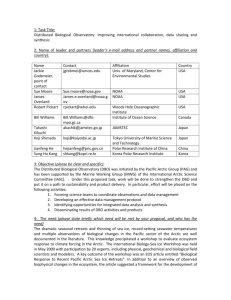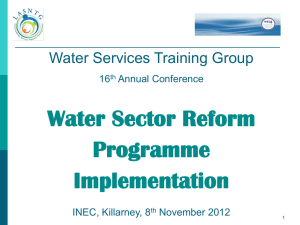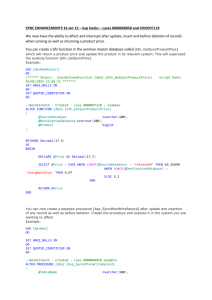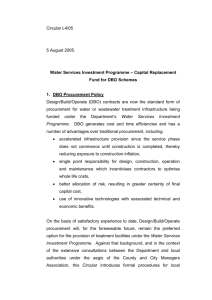Procurement through the use of Design build and Design Build and
advertisement
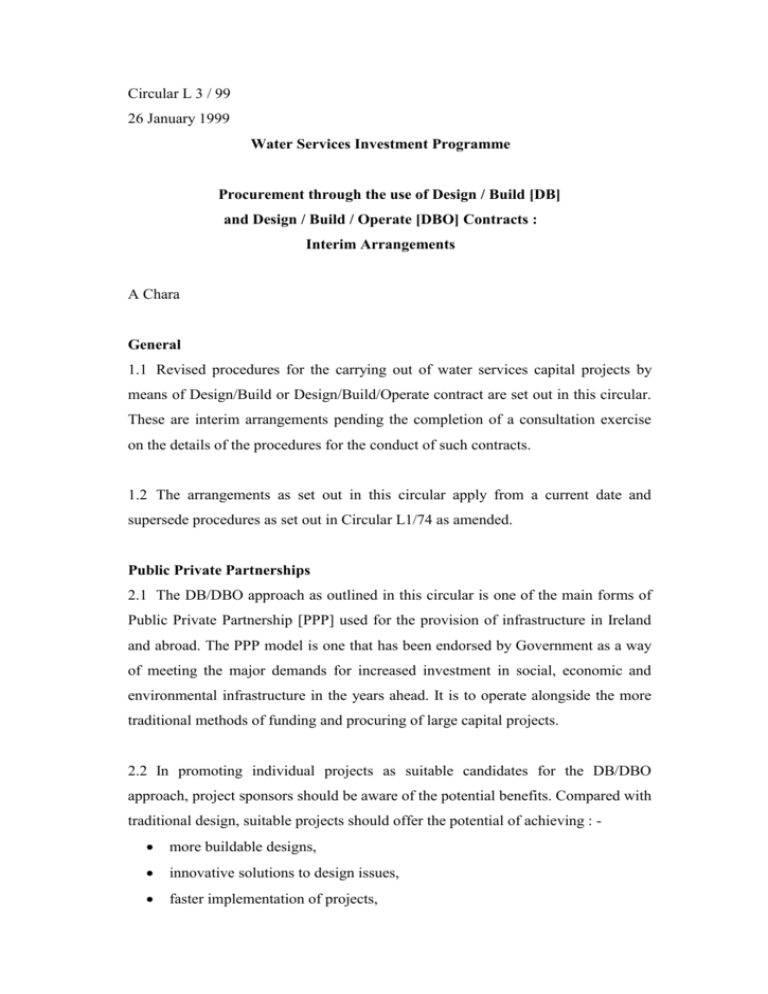
Circular L 3 / 99 26 January 1999 Water Services Investment Programme Procurement through the use of Design / Build [DB] and Design / Build / Operate [DBO] Contracts : Interim Arrangements A Chara General 1.1 Revised procedures for the carrying out of water services capital projects by means of Design/Build or Design/Build/Operate contract are set out in this circular. These are interim arrangements pending the completion of a consultation exercise on the details of the procedures for the conduct of such contracts. 1.2 The arrangements as set out in this circular apply from a current date and supersede procedures as set out in Circular L1/74 as amended. Public Private Partnerships 2.1 The DB/DBO approach as outlined in this circular is one of the main forms of Public Private Partnership [PPP] used for the provision of infrastructure in Ireland and abroad. The PPP model is one that has been endorsed by Government as a way of meeting the major demands for increased investment in social, economic and environmental infrastructure in the years ahead. It is to operate alongside the more traditional methods of funding and procuring of large capital projects. 2.2 In promoting individual projects as suitable candidates for the DB/DBO approach, project sponsors should be aware of the potential benefits. Compared with traditional design, suitable projects should offer the potential of achieving : more buildable designs, innovative solutions to design issues, faster implementation of projects, better value for money, in particular over the life cycle of the works, better risk allocation, greater certainty in construction and operational cost estimation and improved guarantee of enhanced operational performance. While it is recognised that not all projects will be suitable for DB/DBO, local authorities should bear in mind the above potential benefits in assessing the approach to be adopted in individual cases to the planning, design, procurement and operation/maintenance of major water services projects. The Decision to use the DB/DBO approach 3.1 In general, the DB/DBO approach is more likely to prove attractive where the project is of a reasonable size and involves the provision or upgrading of a water or waste water treatment works or other specialist work e.g. tunnelling, major pumping stations etc.. In all such cases the local authority should submit a report on the possible use of the DB/DBO approach along with the Preliminary Report for the scheme.1 [ See paragraph 7.1 for transitional arrangements] 3.2 In a limited number of cases it may be possible to submit the DB/DBO report referred to in paragraph 3.1 at an earlier stage. This might apply, for instance, in the refurbishment / upgrading of a treatment works where there are a few or no planning issues involved. If a decision on the use of the DB/DBO model can be made before the Preliminary Report is prepared this can greatly help in drawing up the PR with the potential for increased benefits in terms of the use of innovative technology and speed of implementation. 3.3 A specialist unit has been set up in the Department which will be available to assist local authorities in assessing the benefits of the PPP model, including the use of DB/DBO contracts, and in the implementation of projects. Standard contracts and forms of procedure will be developed to make the process of implementing DB/DBO based projects as smooth as possible. 3.4 While each case will be determined on its merits, for projects involving the provision or upgrading of a major water or waste water treatment works, the 1 [See Appendix 1 for guidelines on forms to be used in DB/DBO contracts] 2 Department’s policy will be to favour the DB/DBO approach unless there are strong reasons against it. 3.5 In all cases, even where it is decided that the DB/DBO approach is not appropriate, the design documentation and Environmental Impact Assessment should still reflect performance values rather than detailed design specifications in so far as this is possible. The use of alternative design options should be encouraged even within traditional procurement contracts. Using the DB/DBO Approach 4.1 Once a decision is reached to proceed down the DB/DBO route the local authority will be required to undertake the following steps to advance the project :- [i] appoint a consultant to act as ‘clients representative’ for the preparation of a design and performance specification for the DB/DBO contract, the assessment of tenders submitted and the monitoring of the DB part of the contract. In order to fast track a project the local authority may decide to prepare the design specification in-house in tandem with the appointment of consultants, [ii] prepare the performance specification either in-house or through the use of consultants. It is essential that the performance specification should allow the competing contractors to submit alternative and innovative design options. Where the local authority prepares the design specification it will be entitled to charge 2% against the approved capital value of the DB/DBO element of the project. This will be reflected in the negotiations on the client’s representative’s fee, [iii] standard forms and a standard approach to the assignment of risk between the public sector and the successful DB/DBO contractor will be 3 developed as part of a process of consultation with the various interests within the water services industry. In the interim, approval of the Department will be required for the various contract documents, [iv] in cases where the EU Procurement Directives apply, the normal procurement method will be by the restrictive procedure. The various procurement options for a DB/DBO contract are set out in Appendix II, [v] the possible use of an operational contract for a period of up to 20 years should be examined by the local authority. Operational contracts have an important role to play in ensuring that the works procured are built and maintained to the high standard. Operational contracts should include a provision that at the end of the operational period the works be returned to the control of the local authority in an operational state and/or that the contractor be required to maintain through the life of the contract a capital replacement fund to ensure the proper ongoing maintenance and management of the plant and equipment, [vi] advice will be available from a specialist unit within the Department on general matters relating to the use of the DB/DBO approach. Subject to the prior approval of the Department specialist legal advice in relation to contracts may be required by the local authority and charged to the cost of the project. [vii] monitoring, recoupment and reporting arrangements for DB/DBO projects will be broadly similar to those governing traditional projects. Final reports on the project will be required within six months of the substantial completion of the capital works but there will be a requirement for ongoing monitoring and reporting on operational contracts. Project steering groups, involving the local authority, Department and client’s representative, will be put in place as soon as each project is approved. 4 Funding 5.1 Projects that are carried out using the DB/DBO approach will enjoy the same funding conditions as other projects subject to the grants from central funds applying only to the capital works and not to the operational elements of any DBO contract. Management and Operational of Treatment Works 6.1 Where the DBO route is not being followed local authorities are required to outline to the Department their plans for the operation and management of a new or upgraded treatment works no later than one year before the commissioning of the works. General and transitional arrangements. 7.1 The local authority is required to submit a report on the possible use of the DB/DBO approach to the Department in the case of projects of the type referred to in paragraph 3.1.; a) where a preliminary report is being prepared as set out in paragraph 3.1 or b) where a preliminary report has already been submitted to the Department but approval has not yet issued to prepare contract documents. In such cases the report should be submitted as soon as possible. 7.2 While the above revised procedures will generally apply to new projects, the Department may on an ad-hoc basis require the use of the DB/DBO model even where contract documents are being prepared or have already been prepared in the normal manner. 7.3 who Any queries in relation to this circular should be addressed to Colm O’Doherty can be contacted at 8882000 Colm_O’Doherty@environ.irlgov.ie Mise le meas _________________ Eddie Lewis Water Services Section and 5 or on E/Mail at Public Private Partnerships Unit Appendix I : Forms and Procedures This appendix is included for general guidance only. The detailed procedures and the form and documents required will be agreed in consultation with the interested parties over the coming months and information on these will be forwarded to local authorities as it becomes available. 1 Forms to be used in DB/DBO Projects. Project Proposal No change in current arrangements. Project proposals should be in the form set out in Circular L9/98 of 28th October 1998. Project Brief No change. EIS/Preliminary Report Design specification should be based, in so far as this is possible, on performance criteria. DB/DBO Applicability Report New report. See outline of format below. Contract and Tender Documents Revised document format for DB/DBO projects. Guidelines on items to be included in contract documents and on general approach set out below. New version of CONDOC will be prepared to cover DB/DBO projects. Tender Recommendation Tender assessment must take full account of the life cycle costs of the proposals clearly distinguishing between operational/maintenance and capital costs. Final Report / Final Accounts Submission of report on construction phase of the project within six months of substantial completion of capital works. 6 2 DB/DBO Applicability Report A report considering the applicability of the DB/DBO approach to procuring a scheme is to be prepared and submitted with the Preliminary Report for each scheme where the provision of a new or the upgrading of an existing water or wastewater treatment plant is proposed. This report should consider a range of general issues as set out below as they apply to the particular project and the advantages/ disadvantages of a DB/DBO approach as against the traditional procurement approach of separate civil works and M & E plant contract to comply with a consulting engineer’s design. The report should consider in detail whether: i) the nature of the project is such that a performance specification would produce in a better process solution ii) innovative solutions to meeting the scheme objectives, perhaps using newer (perhaps patented) technologies would emerge through proceeding on the DB/DBO approach which would be unlikely to be tendered as an alternative under the present CONDOC or which would not be considered compliant with the contract specification under current procedures. iii) a DBO approach would have advantages/disadvantages in meeting statutory compliances in respect of emission/effluent standards or drinking water standards in the medium to long term operation. iv) a DB approach would better allocate risk for performance in particular with regard to responsibility for process design, performance guarantees and liability etc. v) A DBO approach would offer advantages over and above a DB approach in particular with regard to reliability of equipment and robustness of the process design etc. vi) a DB/DBO approach would have advantages/disadvantages for ongoing maintenance of the plant and equipment. vii) a DB/DBO approach would allow construction to commence at an earlier date than conventional procurement having regard to realistic timescales for contract document preparation and approval, tender periods, tender assessment, tender approvals, signing of contracts, mobilisation etc. 7 3 Instructions to Tenderers It is expected that a new version of the Instructions to Tenders, CONDOC will be prepared specifically for DB/DBO projects using the restricted procedure, or in exceptional circumstances provided for in Directive 93/37/EEC, the negotiated procedure. This would include Form of Tender, Appendix to Form of Tender, Form of Agreement, Schedule of Deviations, Schedule of Imported Items subject to Currency Fluctuation etc. General Conditions of Contract The FIDIC Conditions of Contract for Design-Build and Turnkey have already been approved in principle by Government Contracts Committee for a number of Water Services projects which have proceeded on the basis of DB/DBO. Some amendments are necessary to suit Irish conditions in particular with regard to Rates of Wages and Conditions of Labour, Health and Safety, Tax Clearance, Price Variation, Insurances, and Conciliation and Arbitration and it is expected that these will be included in the new version of CONDOC referred to above as standard amendments to FIDIC. It is also expected that some project specific amendments may be necessary in addition to the these standard amendments. These project specific amendments should be subjected to legal vetting to ensure that the State’s interests are being protected. Contract Documents It is expected that the contract documents would typically contain the following sections: Employer’s Requirements - DB Works (including requirements process, specific design, office/stores, laboratory etc.) Employer’s Requirements - Operation and Maintenance (O & M) Works (including requirements in respect of Health and Safety, personnel, performance standards, sampling and monitoring, reporting, sludge re-use/disposal etc.) General M & E Specification - minimum acceptable standards for materials, pumps and process equipment, instrumentation, building services, testing, workmanship, standby provision, etc. General Civil Specification - Minimum acceptable standards for materials, structures, buildings including finishes, roads, siteworks, landscaping, particular requirements, workmanship etc. Site Information including site survey data, site investigation results, existing plant data where relevant, Planning Information including Planning Permissions, EIS Certificate, Water Abstraction Order, Foreshore Licences etc. Tender Invitation Drawings including drawings prepared for the EIS Requirements for information to be submitted including the locations where the proposed process has previously been installed Requirements for Price Breakdown including clear differentiation between capital and operational/ maintenance costs 8 Appendix 2 : Appointment of Client’s Representative a) appoint a Consultant to act as Client’s Representative under either: the Services Directive 92/50/EEC (as amended by 97/52/EEC) for sewerage schemes or the Utilities Directive 93/38/EEC (as amended by 98/4/EEC) for water schemes including, if the estimated cost of the service contract excluding VAT exceeds the threshold, the publication of a notice in the Official Journal of the European Communities using either the restricted or negotiated procedures as considered appropriate. b) the brief for the Client’s Representative is to include: i) the preparation of a design specification, performance specification, and in the case of DBO contract an operation and maintenance specification ii) the evaluation of tenders received iii) the monitoring of the construction contract including certifying payments iv) the carrying out of the duties of Project Supervisor (Design Stage) until such time as the DB/DBO contractor is appointed to carry out these duties. The approval of the Department of the Environment and Local Government should be sought to the appointment of the Client’s Representative, to the terms of the appointment and to the fee negotiated. 2. Selection of Contractor The restricted procedure under either: the Works Directive 93/37/EEC (as amended by 97/52/EEC) for sewerage schemes or The Utilities Directive 93/38/EEC (as amended by 98/4/EEC) for water schemes is the appropriate procedure which allows for the shortlisting of contractors having regard to their suitablility based on their financial and economic standing and their technical capability. Where the value of the project exceeds the threshold, a contract notice should be published in the Official Journal of the European Communities inviting expressions of interest. The contract notice 9 should specify the range of applicants the contracting authority intend to invite to tender (subject to a minimum of 5) and the criteria which will be used to assess the suitablility of the applicants. A pre-qualification document should be prepared in the form of a questionnaire to be completed by applicants in order to assess their suitability. Criteria for assessing suitability in accordance with the requirements of the Directives should be established and weighted appropriately for the specific project by the contracting authority prior to examining the submissions received in response to the questionnaire. Suitability should be assessed only on the basis of the information on the applicant contained in the submission. The contracting authority may request clarification or supplementary information from an applicant on any matter contained in their submission that is considered ambiguous or lacking in detail. The contracting authority should not take onto consideration any additional information on suitablilty an applicant may submit in response to such a request to rectify any omissions in their original submission . The contracting authority should then shortlist the applicants to be within the range specified in the contract notice provided they do not exclude those applicants who best satisfy the suitablity criteria set out in the contract notice. A report on the relative advantages of those applicants shortlisted over those applicants who met the minimum criteria but did not make shortlist should be kept on record. The shortlisted candidates should then be issued with the approved tender documents and invited to submit tenders. In exceptional circumstances, where the conditions provided for in Article 7 of Directive 93/37/EEC exist, contracting authorities may use the negotiated procedure instead of the restricted procedure. The procedure to be followed should be as set out above for the restricted procedure with at least three candidates being shortlisted and invited to tender. On receipt of tenders one tenderer should then be selected on the basis of established criteria and invited to negotiate a contract. 3. Evaluation of Tenders The contract should be awarded to the most economically advantageous tender having regard to technical merit, price, running costs, period for completion. Technical merit should include and assessment of whether the process proposed is proven in similar circumstances, the reliability of both the process and equipment offered, and the flexibility of the process offered to cater for any anticipated variation in design load. Running costs should include both operating and maintenance costs. In this regard the tender documents should advise the tenderers of the unit costs for power, chemicals, sludge transportation and disposal , etc. that will be used to evaluate the whole life costs of the proposed process. 10 The period for completion might be taken into consideration in certain circumstances where early completion has an economic benefit to the contracting authority. 4. Award of Contract The award of the contract should be subject to the approval of the Minister of the Environment and Local Government and subject to the usual requirements with regard to a performance bond, insurance, tax clearance etc. 11
